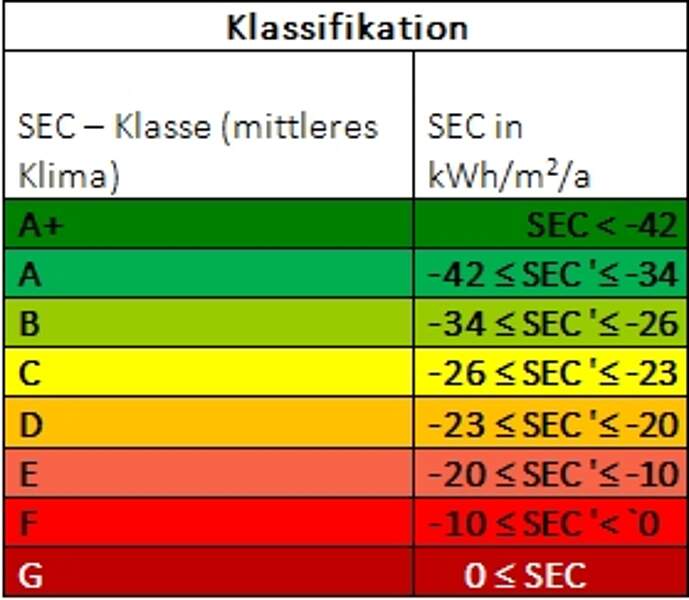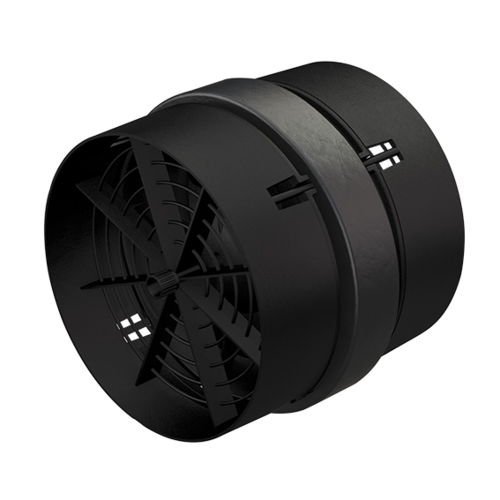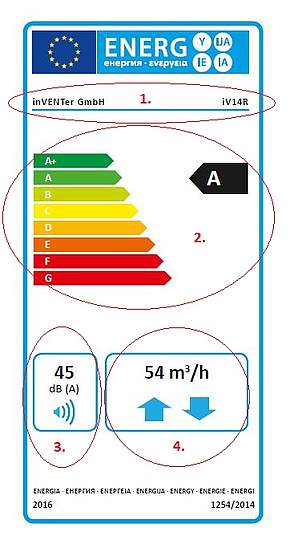The energy efficiency label for ventilation systems
The energy efficiency label is known from many technical devices: colored efficiency scales make the energy consumption of products visible and make it easier for customers to choose energy-efficient products when buying.
Decentralized ventilation systems are also divided into efficiency classes and identified accordingly. The use of the energy label is intended to help achieve national and European climate protection goals by gradually displacing inefficient products from the market.
Transparency in the market through energy efficiency classes
The energy efficiency label is based on a framework directive on the Europe-wide uniform energy consumption labeling of products. The European Union lays down the framework for the allocation of efficiency classes. Specifically, the EU framework directive 2010/30 / EU of the European Parliament and of the Council of May 19, 2010 on the “Indication of the consumption of energy and other resources by energy-related products by means of uniform labels and product information” is implemented.

Energy efficiency label for ventilation systems
Since the beginning of 2016, it has also been mandatory to mark residential ventilation systems with an energy efficiency label. For ventilation systems, the best efficiency class was defined as A +, the worst with G. The basis of the comparison is window ventilation, classified in class G. These classes generally describe how much energy can be saved by the device. They are stored with the so-called SEC value. This is calculated from the electrical energy used minus the primary energy saved.
Class F, for example, stands for savings of 0.1 to 10 kWh / m² / a. This means that even with a class F device, energy is saved compared to window ventilation. Class A + describes the greatest possible saving of at least 42 kW / m² / a. The label also provides information on the maximum air flow rate, the device noise and the type of ventilation device.

Energy efficiency class A + for energy-efficient ventilation from inVENTer
InVENTer’s ventilation systems consistently achieve energy efficiency class A. In combination with a sensor or the MZ-Home controller, various models are even classified in efficiency class A +. This combination of sensors with the MZ-Home controller enables needs-based ventilation. It is only ventilated as much as necessary.

This reduces the energy consumption of the device and the ventilation heat losses. For example, a system consisting of the new iV-Smart + fan with inVENTron technology and the MZ Home controller achieves up to 93% heat recovery. Even when viewed as a whole over the year, the average heat recovery is over 80 percent.
Label information for energy-efficient ventilation

1st section:
- Supplier name and fashion
2nd section:
- Energy efficiency class A + to G
- This is calculated in accordance with the regulation as follows:
- Consumed electrical energy - saved primary energy = SEC ⇒ value for determining the class.
3rd field on the left:
- Sound power level at 70% of the maximum air volume flow. The sound power level differs significantly from the
- Sound pressure level; it is approx. 8 dB (A) higher.
- Sound power is the "volume" emitted by the source regardless of the distance.
4th field on the right:
- Specification of the maximum air flow related to the supply air. The two arrows symbolize bidirectional operation.
The future of the energy efficiency label in ventilation
Ever more efficient devices make it necessary to adapt the ERP guideline. In some product groups today there are almost only differences between A + to A +++. As a result, the efficiency classes should be adjusted by 2024 at the latest, then with the reduced categorization from A to G. There are currently considerations as to whether the materials used should be included in the assessment in order to take into account the effects on the environment outside of operation. This revision should then apply to all product groups.
Delimitation of central and decentralized ventilation systems
In spite of everything, the decision as to which type of ventilation system to install should never be made on the basis of a label alone. Ventilation systems are complex systems, the efficiency of which is influenced not only by the individual device, but also by the perfect coordination of all components. They either consist of a central device with pipes (central ventilation system) or several decentralized devices for a usage unit (decentralized ventilation system). As already mentioned, a comparison is only possible within the same product groups – that is, central ventilation systems with one another and decentralized ventilation systems with one another.

Conclusionon the subject of energy efficiency labels for ventilation systems
In summary, one can say that the energy efficiency label is a good means of getting an initial overview of the efficiency of a ventilation device. However, the label does not provide any information about the operating costs of the device; the entire system must be considered for this. The operating costs depend on several factors, for example the type and number of devices used. Because it is a device label and not a system label, additional components, such as the frost protection strategy or a post-heating register in central systems, are not taken into account. In any case, a specialist should be consulted before deciding on a ventilation system.


